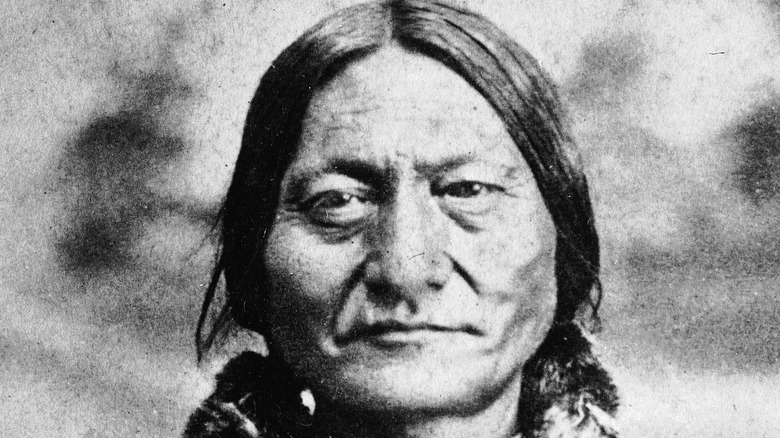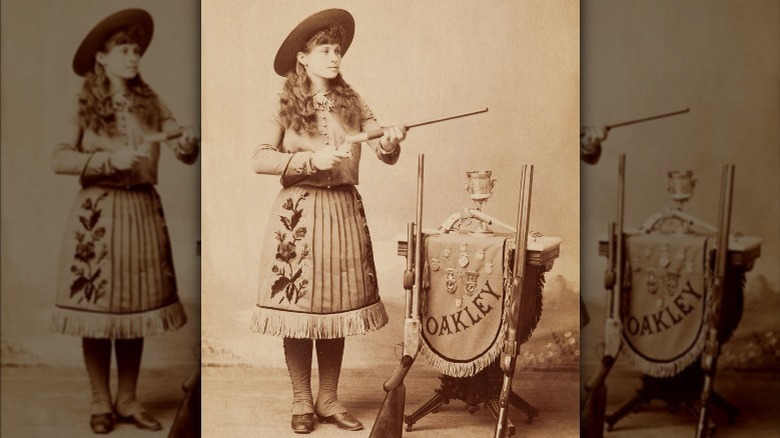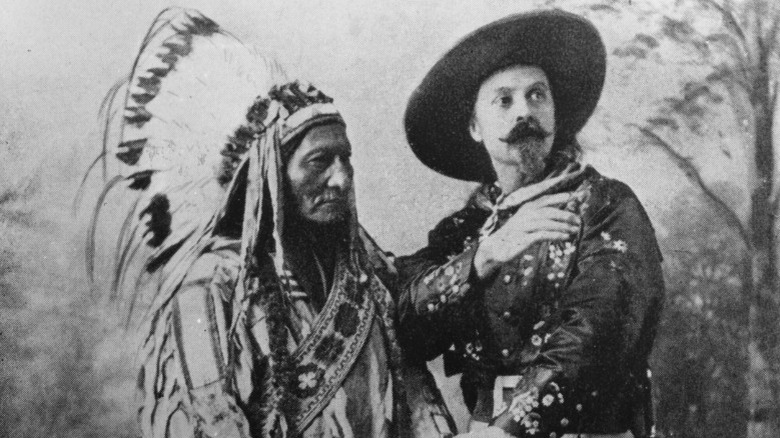The Truth About Sitting Bull And Annie Oakley's Relationship
Sitting Bull was a Teton Dakota Indian chief who was instrumental in unifying the Sioux tribes to fight against white settlers who were taking away their land. On June 25, 1876, the Battle of the Little Bighorn ensued. Lieutenant Colonel George Armstrong Custer led troops to fight against Cheyenne and Lakota Sioux warriors. Per History, Custer and his men were significantly outnumbered by the Indians under the direction of Sitting Bull. About 2,000 Sioux decimated Custer and his 200 men, which in turn heightened the white Americans' rage against the tribes. The efforts to take over Native American lands were doubled, and Sitting Bull made the decision to flee to Canada to keep his people safe.
In 1881, Sitting Bull came back to the Dakota territory to surrender himself on the condition of reprieve for his people. He was kept prisoner at Fort Randall until 1883, and he moved to Standing Rock Reservation upon his release. In 1884, Sitting Bull was granted permission to travel alongside an agent, Alvarez Allen, on a tour of different cities. He took the opportunity to bring attention and funds for his people at the reservation (via The Annie Oakley Center Foundation). It was at that time when Sitting Bull met Annie Oakley.
Annie Oakley impressed Sitting Bull
Annie Oakley — born Phoebe Ann Moses in 1860 — was a magnificent markswoman and was especially popular due to her sharpshooting skills in the male-dominated sport. At just 15 years old, Oakley competed against Frank E. Butler, who at that time traveled in different parts of the country to show off his shooting skills and participate in competitions. In their match, Oakley shot all 25 of her targets and won against Butler, who missed one. According to Women's History, the two began a romantic relationship soon after, and they married in 1876.
Oakley and Butler performed and toured the country together. The couple was in Minnesota in 1884, and Sitting Bull was in attendance. Oakley's sharpshooting skills impressed Sitting Bull so much that he sent $65 to her hotel just to take a photograph with her, per American Experience. Oakley sent back the money and said that he would call her the next day. Their initial meeting was the start of a great friendship. Sitting Bull even had a nickname for Oakley — Watanya Cicilia — which means Little Sure Shot.
Sitting Bull unofficially adopted Annie Oakley as his daughter
In 1885, Sitting Bull started touring with Buffalo Bill Cody's Wild West show together with Annie Oakley. He was part of the opening procession and was paid $50 a week — a generous compensation at that time. Sitting Bull was also able to make more money by selling his autographs for $1 each, according to American Experience. According to Oakley, Sitting Bull insisted on adopting her as his daughter — though not officially. "He had asked me to take the place of the daughter he lost shortly after the Custer massacre," Oakley said.
To signify the unofficial adoption, Sitting Bull gifted Oakley the moccasins — which was made by his daughter — that he wore during the Battle of the Little Bighorn. Oakley also thought highly of the Lakota leader. "He fought justly, for his people had been driven from their God-given inheritance and were living upon broken promises," she said (via Annie Oakley Center Foundation). Sitting Bull's daughter was close in age to Oakley, and he treated her as his own. "He is a dear, faithful, old friend, and I've great respect and affection for him," Oakley said of her relationship with Sitting Bull.


